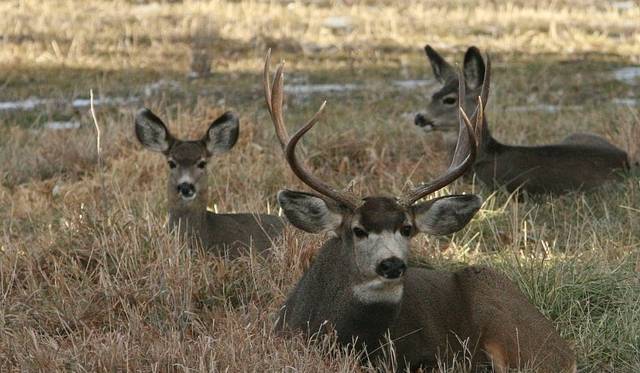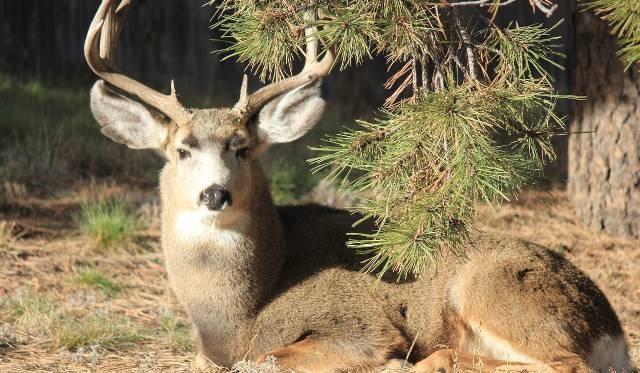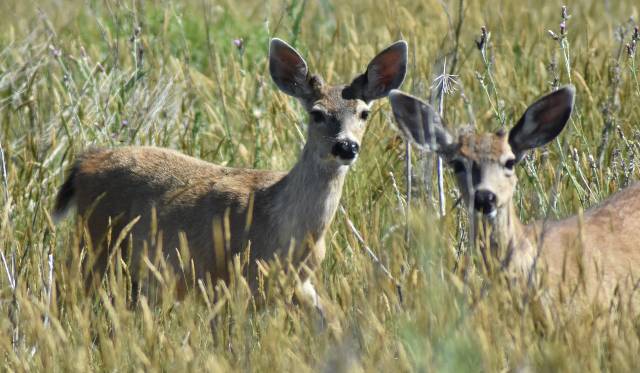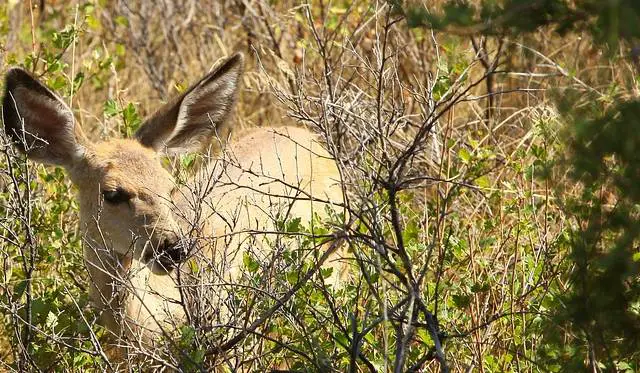Deer bedding is an essential aspect for any hunter, wildlife enthusiast, or property owner looking to create suitable habitat for deer. Understanding deer bedding and how it affects deer behavior can help you create better strategies for hunting success, supporting habitats, observing, or conserving these animals.

You may already know that buck or doe bedding areas refer to the location where deer lay down to rest, chew their cud, and seek shelter from the elements or predators. These areas can be found in a variety of habitats, such as wooded areas, grasslands, and even swamps.
Taking the time to learn more about buck bedding locations and the factors that drive deer to select certain areas for bedding cover can provide invaluable insights, helping you enhance your property or hunting experience during different seasons.
Contents
- Habitats for Deer Bedding
- Seasonal Changes and Deer Bedding
- Human Impact on Deer Bedding
- Enhancing Deer Bedding Areas
- Deer Bedding: FAQs
- What do deer prefer for bedding material?
- What does buck beds look like?
- How often do deer use the same bedding area?
- What times do deer go to bedding areas?
- How to find a deer bedding area?
- What are some tips for approaching a bedded deer stealthily?
- How far will deer travel from bedding to food?
- Should you hunt deer bedding areas?
Habitats for Deer Bedding
Creating a suitable environment for buck bedding is crucial to ensure the overall health and well-being of the deer population in your area. There are various types of habitats deer prefer for cover including forests, wetlands, and grass heavy spaces.
Grasslands
Grasslands offer excellent bedding cover for deer, especially if they contain a diverse combination of grasses, shrubs, and other plants. This variety provides the necessary ground cover and security for deer, particularly for doe beds.
Buck bedding areas are more likely to be found on the edges of grasslands or within small clusters of trees or shrubs within the grassland itself. These locations offer mature bucks the necessary seclusion and cover they need when bedding down.
Forests
Forests provide deer with ample bedding cover, as they tend to select locations within dense patches of coniferous trees or areas of heavy undergrowth. The thick cover provided by these environments enables deer to feel safe and secure while they rest.
Buck beds are often found in more remote forest locations, away from those frequented by the general deer population. Mature bucks place a greater emphasis on security; they often choose bedding sites on the leeward side of hills or on elevated terrain, which offers a vantage point to detect predators or disturbances. Scout this type of buck bedding area when hunting mature bucks.

Wetlands
Wetland areas can also provide ideal bedding locations for deer. They often contain dense vegetative cover, such as cattails and reeds, that provide bedding cover for does and fawns. Since these environments tend to be less disturbed by human activity, they can provide a safe refuge for deer.
While mature buck bedding in areas within wetlands are less common, they can still be found in unique locations that offer seclusion. Mature bucks may choose a buck bed on small islands or hummocks within the wetland, making it difficult for predators to approach their bedding site.
Seasonal Changes and Deer Bedding
Spring and Summer Bedding
During the spring and summer months, deer tend to seek out bedding areas that provide both cover and comfort. This often means bedding in dense grasses or brushy areas. One thing to keep in mind is that deer, especially does with fawns, will often prefer areas with native warm season grasses due to their bunch-like structure, providing natural cover.
In addition to cover, deer will also be seeking out cooler temperatures. As a result, southwest facing slopes are a popular choice for a deer bedding area during these warmer months. The slopes provide shade and cooler temperatures, making it a more comfortable spot for deer to rest during the day.
Fall and Winter Bedding
As the seasons change and temperatures drop, so do the bedding preferences of deer. During the fall and winter months, deer are more likely to bed down in areas that offer protection from the elements. This can include bedding near corn or soybean fields, which can provide both cover and a food source.
Additionally, buck bedding areas and doe beds will change based on food sources. As the months progress, some food sources die out while others begin to produce, causing deer to alter their bedding locations accordingly.
During the colder months, pay close attention to the wind direction and thermal cover. Deer will choose bedding areas that block cold winds or provide thermal cover to help keep them warm. This can result in buck beds in thickets, wooded areas, or even in the leeward side of a hill or slope.
Understanding how seasonal changes affect bedding area is crucial for both hunters and wildlife enthusiasts alike. Adapt your approach based on the time of year.
Human Impact on Deer Bedding
Urbanization
Urbanization is a major factor that influences bedding behavior. As cities and towns expand, the natural habitat of deer gets disrupted, altering their bedding patterns.
Deer often need to adapt to new environments and seek alternative bedding areas. This can lead to deer searching for cover in areas that may pose a higher risk for them, such as being closer to human activities, buildings, and roads.
When deer are exposed to human or other forms of intrusion, their sense of smell plays a critical role. They use their strong sense of smell to detect any potential danger and select appropriate places to bed down.
Tip: Be mindful of your presence, as strong scents or excessive noise may disturb them and alter their bedding habits.
Hunting
Hunting pressure has a significant impact on deer movement and bedding behavior as well. During hunting season, deer become more cautious and may alter their movement patterns to avoid encounters with hunters.
Throughout the course of the season, deer may seek more concealed and hard-to-reach areas for their buck bed or doe bed in order to avoid detection. In response to hunting pressure, deer may also opt for bedding locations with a better vantage point, such as ridges or hilltops, which enable them to better detect predators or humans approaching.
While you’re hunting, consider factors such as wind direction and your own scent. Deer are adept at detecting human presence through smell.
Taking precautions, such as using scent-control techniques, can help mitigate the impact of other hunters and your intrusion on their bedding behavior. Remember that deer are highly adaptive creatures, and understanding their habits and responses to human activities is key to being a responsible and successful hunter.

Enhancing Deer Bedding Areas
Improving Natural Habitats
Deer need a secure and comfortable bedding area to rest during the day. If you are a landowner, you can enhance these natural habitats by providing cover and taking steps to ensure their safety. One approach is to hinge-cut trees in clusters, which creates attractive and specific bedding locations within the area.
Another essential element for a successful bedding area or habitat is inviolate areas on your property. Zones where human intrusion is limited, making deer feel more at ease.
It’s also crucial that you manage the vegetation within the bedding area, enabling deer to have clear lines of sight while still being concealed from predators.
Establishing Food Plots Near Buck Bedding Areas
By providing deer with easily accessible food sources near their bedding areas, you can entice them to spend more time on your property. Planting food plots not only provides nourishment for the deer but also adds much-needed cover.
When deciding on the types of plants, consider those that offer high nutritional value and grow well in your region. Some popular options are clover, brassicas, and soybeans.
In addition to planting food plots, maintain a diversity of natural forages for deer to feed on throughout the day by removing undesirable plants in the area. This promotes the growth of more desirable and nutritious plants such as clover that benefit your deer population.

Deer Bedding: FAQs
What do deer prefer for bedding material?
Deer typically prefer to bed in tall, thick grass or brushy areas that provide cover and a sense of security. To create an ideal bedding spot, plant grass and maintain it through fertilization and watering if possible.
What does buck beds look like?
Buck bedding areas are typically found in thicker vegetation or thick brush, with a depression in the middle where the animal has laid down. There may be flattened grass, leaves, or branches showing the outline of the buck’s body within buck beds.
How often do deer use the same bedding area?
Deer may reuse the same bedding area often, depending on factors like food availability, predator activity, and disturbances. However, they are also adaptive creatures and may change bedding locations when needed.
What times do deer go to bedding areas?
Deer generally bed down during daylight hours, seeking shelter and rest after a night of foraging. They may also use bedding areas for brief periods throughout the day, depending on their activity levels and external factors like weather and hunting pressure.
How to find a deer bedding area?
Scouting is crucial when locating bedding areas on public land or private land. Look for signs of deer activity, such as droppings, tracks, or rubs. Focus on thick areas of cover, like swamps or brushy areas, that deer may use for security. Be patient, quiet, and thorough in your search to increase your chances of finding a bedding area.
What are some tips for approaching a bedded deer stealthily?
When approaching a bedded deer, be mindful of your noise levels and use slow, deliberate movements. Pay close attention to the direction of the wind, and what you touch like brush or leaves, as you don’t want your scent to alert the surrounding deer. Observing from a distance and using binoculars can help minimize disturbances.
How far will deer travel from bedding to food?
Deer usually travel between 0.5 to 1.5 miles from their bedding area to a food source. However, the distance can vary based on factors like habitat quality, food availability, and hunting pressure.
Should you hunt deer bedding areas?
Hunting deer bedding areas can be productive, but it’s essential to do so cautiously to avoid pressuring and relocating the deer. Utilize observational tactics, such as looking for deer sign, scouting and observation stands, to gather information needed for successful hunts in bedding areas. Remember, hunting pressure can quickly change deer behavior, so balance your strategies accordingly.